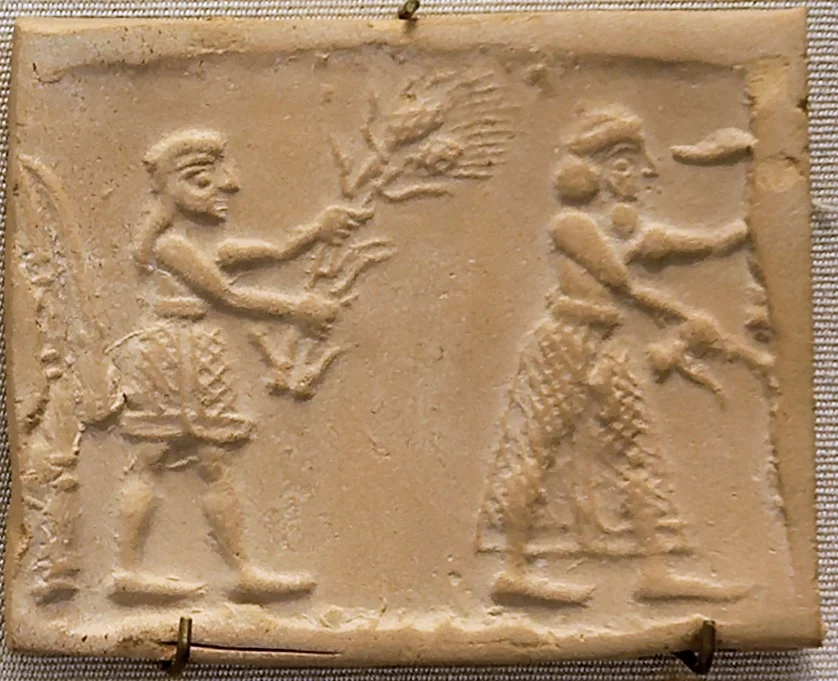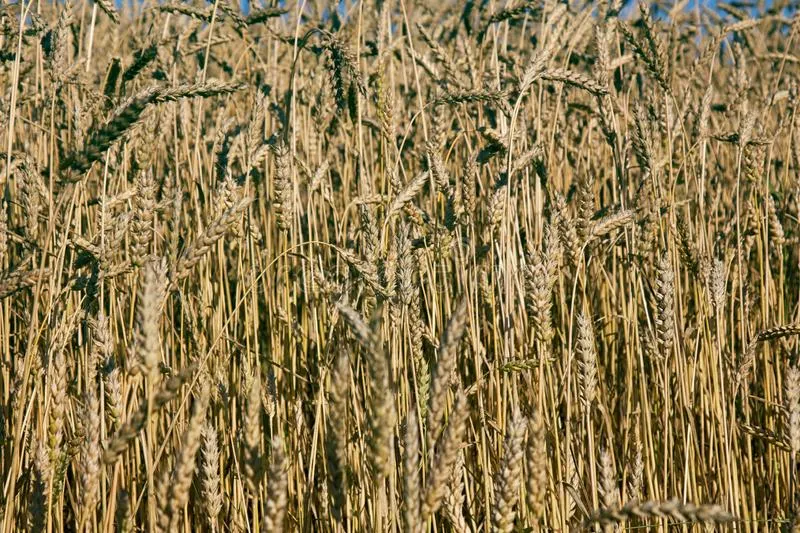Evolution of Wheat Since the Neolithic

The evolution of cultivated wheat presents challenges most Creationists will avoid if possible. The first and perhaps most obvious challenge is why has wheat needed to be improved by cultivation and human selection if, as Creationists believe, it was created by a perfect, omniscient designer for the benefit of humans? Did the designer not foresee the future needs of humans or anticipate the problem of feeding a large population from a crop with inadequate yields?
The second is that fact that, despite the ludicrous Creationists' insistence that the Theory of Evolution (TOE) is a theory in crisis, and about to be overthrown as a scientific theory by their superstition, including magic and an unproven magical entity, the only viable explanation for the changes which have occurred over time is selection by human agency, in other words a form of accelerated evolution by natural selection and primitive genetic engineering by people who knew nothing of genetics, just like the natural environment.
Archaeological records show that, for about 10,000 following the first cultivation of wild wheat in Mesopotamia about 12,000 years ago, wheat grains had long awns, then about 2000 years ago, wheat diversified into awned and awnless or very short awned varieties.
Clearly, given the length of time awned whet was grown, there was not strong selection for awnless wheat, so why did the different varieties evolve, apparently suited to different environmental conditions. This was the question a study, published in the journal Trends in Plant Science, co-led by the University of Barcelona, the Agrotecnio centre and the University of Lleida, set out to answer. Creationists might note that nowhere does magic or a magic entity appear in the explanation, which depends in its entirety on the workings of the TOE.
The research and its significance are explained in a University of Barcelona news release:
Around 12,000 years ago, the Neolithic revolution radically changed the economy, diet and structure of the first human societies in the Fertile Crescent of the Near East. With the beginning of the cultivation of cereals —such as wheat and barley— and the domestication of animals, the first cities emerged in a new social context marked by a productive economy. Now, a study published in the journal Trends in Plant Science and co-led by the University of Barcelona, the Agrotecnio centre and the University of Lleida, analyses the evolution of wheat spikes since its cultivation began by the inhabitants of ancient Mesopotamia —the cradle of agriculture in the world— between the Tigris and the Euphrates.Sadly, the team's paper, published in Trends in Plant Science is behid a paywall, but in their abstract, they say:
The authors of the study are Rut Sánchez-Bragado and Josep Lluís Araus-Ortega, from the UB Faculty of Biology and Agrotecnio-UdL; Gustavo A. Slafer, ICREA researcher at the UdL School of Agrifood and Forestry Science and Engineering, and Gemma Molero, from the International Maize and Wheat Improvement Center in Mexico, currently a researcher at KWS Seeds Inc.
A cereal that changed human history
The cultivation of wheat — a grass that became basic food — represented a turning point in the progress of human civilisation. Today it is the world's most important crop in terms of food security, but EU data warn that the impact of climate change could significantly increase its price and modify its production process in certain areas of the world.
It is important to conduct studies that show which wheat varieties are best adapted to different environmental growing conditions, especially in a context of climate change. Studying the past retrospectively can give us an idea of the evolution of wheat cultivation over the millennia since agriculture appeared in ancient Mesopotamia.
Awns are organs of the spike that have traditionally been associated with the plant's adaptations to drought conditions", says Josep Lluís Araus, professor at the Department of Evolutionary Biology, Ecology and Environmental Sciences of the Faculty of Biology.
However, archaeological and historical records show that the wheat spike has existed predominantly with awns for more than ten millennia after the domestication of wheat. It is not until the last millennium that evidence shows in many cases the absence of awns, indicating a selection by farmers —probably in an undirected way— against this organ.
However, in wetter climates the awns accumulate moisture and can promote the spread of diseases, so, as the world's population is continuously growing, it is necessary to investigate the role of the awned spikes in the changing conditions of our climate in order to meet the world's demand for a primary food commodity such as wheat.
Dr. Rut Sánchez-Bragado, first author of the study
Secció de Fisiologia Vegetal,
Facultat de Biologia
Universitat de Barcelona, Lleida, SpainThe role of wheat awns in their performance remains controversial despite decades of studies.
Gustavo A. Slafer, corresponding author
Department of Crop and Forest Sciences
University of Lleida, Lleida, Spain.Throughout the domestication process of wheat, the plant phenotype has undergone both rapid (within a few hundred years) and slow (thousands of years) changes, such as the weakening of the rachis, the increase in seed size, and the reduction or disappearance of the awns. In particular, awned and awnless wheat varieties are found all over the world, although the latter tend to be abundant in regions with arid climates, especially during the final stages of cultivation in late spring, a condition typical of Mediterranean environments.[In arid conditions, the spikes —including the awns—] have better physiological characteristics than the leaves. In addition, the awns allow the light captured by the crop to be more diffused, which facilitates a better distribution of light energy and allows the crop to photosynthesise more. Therefore, in arid conditions, the awns can still be beneficial for the crop, or at most, neutral.
[Although there is no scientific consensus,] everything suggests that in conditions where the plant does not suffer from water stress, the extra photosynthetic capacity of the awns does not compensate for other potential negative effects (reduced susceptibility to fungal diseases, limitation in the total number of large ones that an ear supports, etc.)
Professor José L. Araus, co-author
Secció de Fisiologia Vegetal
Facultat de Biologia
Universitat de Barcelona, Lleida, Spain
HighlightsSo, the TOE is looking fit and well in the University of Barcelona, where biologists depend on it to explain the observable evidence and don't need to resort to citing magic and ancient mythology.
The role of wheat awns in yield has remained controversial despite decades of studies.
Archeological and historical records show that wheat spikes were predominantly awned across many millennia after domestication, while small awns or awnless spikes were common during the last millennium.
The meta-analysis conducted in this review shows that the presence of awns significantly increases average grain weight by 5% at the expense of grain number, which is reduced by 3% independent of the environmental growing conditions.
The increase in grain weight is not associated with an increase in spike photosynthesis but rather as a constitutive effect that increases the failure of distal grains or increases the grain size potential of all grains.
No clear advantage or disadvantage due to the presence of awns was observed for wheat yield across favorable and stressful environments.
Abstract
Awnless and awned wheat is found across the globe. Archeological and historical records show that the wheat spike was predominantly awned across the many millennia following domestication. Thus, ancient farmers did not select against awns at least until the last millennium. Here, we describe the evolution and domestication of wheat awns, quantifying their role in spike photosynthesis and yield under contrasting environments. Awns increase grain weight directly (increasing the size of all grains) or indirectly (increasing the failure of distal grains), but not as a consequence of additional spike photosynthesis. However, a trade-off is produced through decreasing grain number. Thus, favorable effects of awns on yield are not consistently found across environments.



No comments :
Post a Comment
Obscene, threatening or obnoxious messages, preaching, abuse and spam will be removed, as will anything by known Internet trolls and stalkers, by known sock-puppet accounts and anything not connected with the post,
A claim made without evidence can be dismissed without evidence. Remember: your opinion is not an established fact unless corroborated.